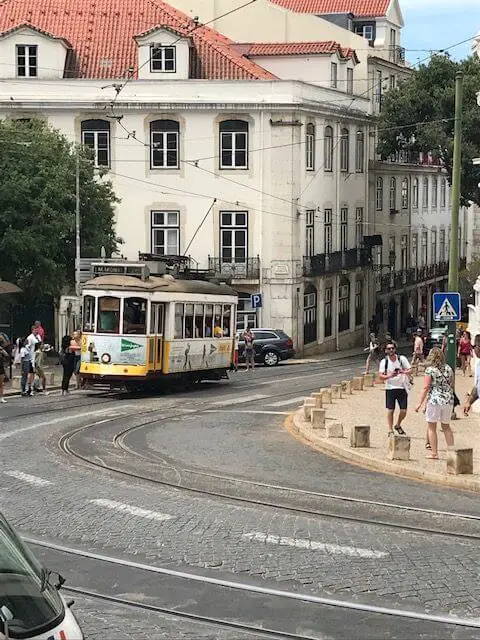
Here is a guide for how to ride Lisbon’s trolleys, cable cars, elevators, and buses. When you go to Lisbon, inevitably, you will be riding the trolleys, cable cars, elevators, and buses. And it will be an enjoyable part of your vacation!
While the trolleys are a lot of fun (going up and down the hills sometimes reminds you of being on an old wooden roller coaster – only not nearly as scary), Lisboetas have been getting around town and uphill on these beautiful wooden carriages since before there was electricity.
At first, the coaches were pulled by horses. Then they turned to steam-power.
These days, everything is electric.
There are six tram lines in Lisbon. Locals call them “elétricos.”
The letter E after the number stands for “elétrico.”
The trams have several brakes in case one fails.
There is an electric brake, a handbrake, and a pneumatic brake.
Riding Lisbon’s street cars or elétricos
Tram 28E
28E started running in 1914. It is, by far, the most popular tram in Lisbon, because it passes by so many of Lisbon’s most famous sites and miradouros, (Mira De Ouro = Golden View) or scenic viewpoints.
Today the route is 4.5 miles long and begins at Martin Moniz and ends at Prazeres in the Campo de Ourique neighborhood.
Trams come every 10 to 12 minutes and the entire trip lasts close to an hour.
The maximum speed is 50 km/h depending on traffic.
Tram 28 starts running at 6 AM, with the last one departing at 11 PM on weekdays, and 10:30 PM on weekends
If you like, you can stay on the tram and ride back in the opposite direction.
Many people try to hop on and off of 28E and 12E.
This is allowed, but often it is hard to find a seat in the middle of the route.
If you use the zapping option on the Viva Viagem card, you have to get back on a tram within an hour, or you will be charged for a second ride.
Tram tickets are three euros for a single trip and can be purchased from the driver.
It’s easier to use a prepaid card such as the Lisboa Card or the Viva Viagem card.
There is also a 24-hour public transport ticket for €6.40 that you can buy at the metro station.
These are good on all trams, buses, and the Metro.
Enter through the front door and validate your ticket by scanning it behind the driver.
Lisbon is a very safe city with very little crime.
You are most likely to encounter a crime on tram 28 or while you are in line waiting for tram 28.
Unfortunately, the tram is a hotspot for Europe’s best pickpockets.
I would advise you not to carry unnecessary cash, credit cards, or travel documents if you are planning to ride the train.
Major stops on tram 28
- Martim Moniz
- Graça (Miradouro da Graça, Miradouro da Senhora do Monte, and Miradouro do Jardim da Cerca da Graça)
- Calçada de São Vicente (Monastery of St. Vincent, National Pantheon, Feira da Ladra on Tuesday and Saturday.
- Largo das Portas do Sol (Miradouro das Portos do Sol), Museum of Decorative Arts, Miradouro da Santa Luzia
- Sé Cathedral. Across the street is St. Anthony Church. Down the street is the Aljube Museum (formerly a prison, it is now a museum that remembers the victims of and the resistance to the Portuguese dictatorship), and the remains of the Roman Theatre.
- Rua da Conceição. Near here Rua Augusta Arch and Rua Augusta shopping street.
- Praça Luís de Camöes (Chiado shopping, bars and restaurants in Bairro Alto, the Bica Funicular, Miradouro de Santa Catarina, Igreja de Santa Catarina)
- Estrela (Basílica da Estrela and Jardín de Estrela)
- Campo d’Ourique (Prazeres) (Prazeres Cemetery, Mercado de Campo d’Ourique, or take the tram back to Praça Martim Moniz.
For more on Tram 28E, see my article Where does Tram 28 stop? All you need to know about Tram 28
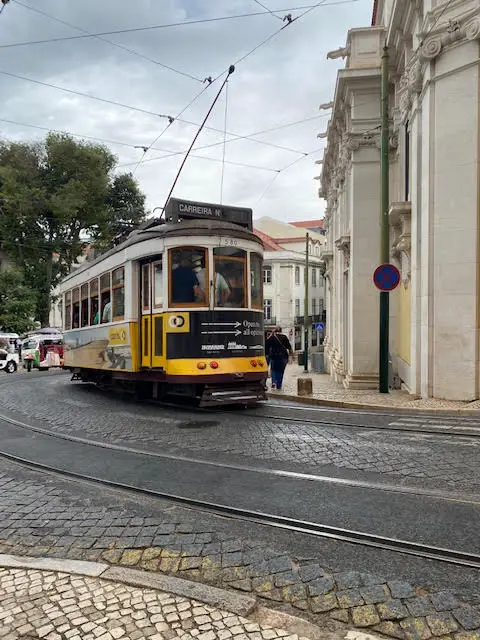
Tram 18E
Use this tram if you want to go to Torre de Belém or the Mosteiro dos Jerónimos.
Tram 15E
You can also Use this tram if you want to go to Torre de Belém or the Mosteiro dos Jerónimos.
Try to board the tram at Praça da Figueira for the best chance of getting a seat.
This sleek, modern tram is usually packed. It is also very popular with some of the world’s best pickpockets.
The most interesting stops on this route are:
- Praça da Figueira
- Praça do Comércio
- Cais do Sodré train station
- Calvário (nearby LX Factory and Docas de Santo Amaro)
- Belém (Coaches Museum, Monument to the Discoveries, Mosteiro dos Jerónimos.)
- Algés (Last stop)
To learn more about Tram 15E, read my How to get from Alfama to Belém (Hint: Tram 15E)
In order to get to Belém though, the train from Cais de Sodré is a faster and less crowded option. So is bus 728.
Also, you cannot buy a ticket from the driver on this route.
The machine does not give change, and it only accepts coins.
Your best bet is to pay with a card.
There are two types of cards.
You can buy the Viva Viagem card at a metro station such as Rossio or Praça de Figueira.
The Viva Viagem card costs $.50 and you can load it with cash for zapping deductions, or with a 24-hour ticket, which costs €6.40.
A round-trip ticket to Belém on the tram costs six euros, so if you will be using any other public transportation that day, then the 24-hour card is a great deal. See What is the Viva Viagem Card? Everything you need to know
The Lisboa card is good for all transportation in Lisbon, and you can buy a 24, 48, or 72-hour card.
The Lisboa card also provides free or reduced admission to most attractions in town. To learn more, go to my article Lisboa Card | Everything you need to know
Tram 12E
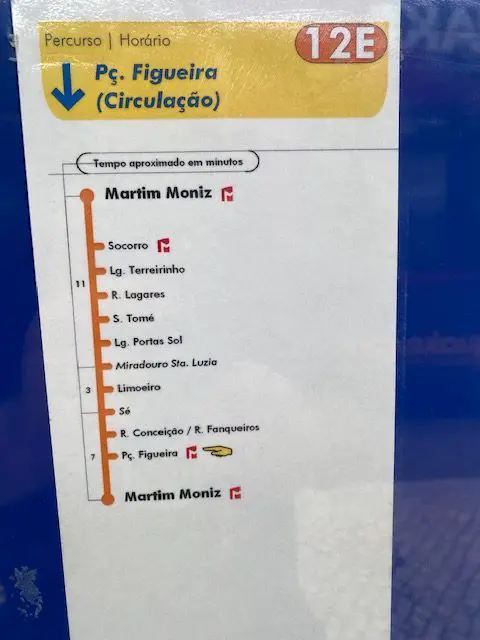
A circular route starting at Praça Martim Moniz which passes Miradouro das Portas do Sol, Sé Cathedral, and Praça da Figueira.
Tram 24E
Starts at Praça Luís de Camões in Chiado, climbs uphill toward São Roque church, and the São Pedro de Alcântara viewpoint in Bairro Alto, Príncipe Real, and ends near Amoreiras Shopping center. See my article Where to shop in Lisbon
Funiculars (known as elevators or ascensores)
Ascensor da Glória
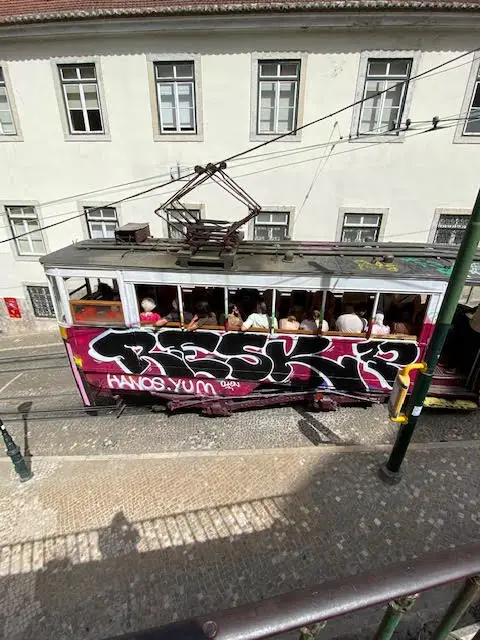
The Ascensor da Glória funicular started running in 1885.
It runs on a 275 m track from Restauradores Square on Avenida da Liberdade uphill to Bairro Alto and is very close to the São Pedro de Alcântara viewpoint once you arrive in Bairro Alto.
It goes up an 18° slope.
The alley is covered in graffiti and murals. Some of the murals are excellent. See my article How to get to Bairro Alto? (Hint: Take the Glória Funicular)
Ascensor da Bica
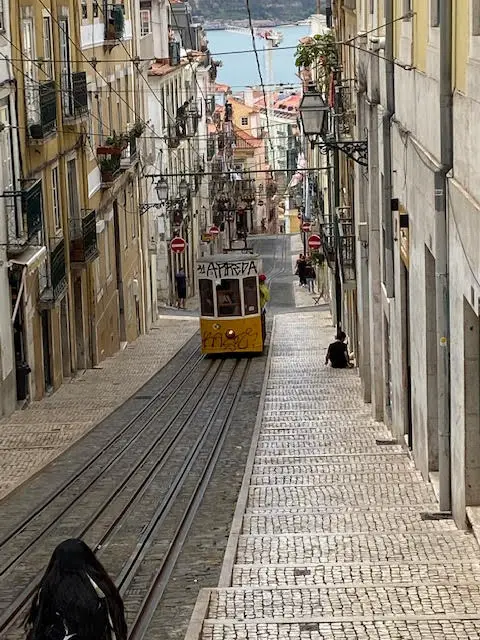
Another beautiful view, this elevator travels up and down Rua da Bica de Duarte Belo.
It has been running since 1892.
You can board in the Cais do Sodré neighborhood at Rua de São Paulo or at the top at Largo do Calhariz near Bairro Alto.
For more information read my Top things to know about the Elevador da Bica
Ascensor do Lavra
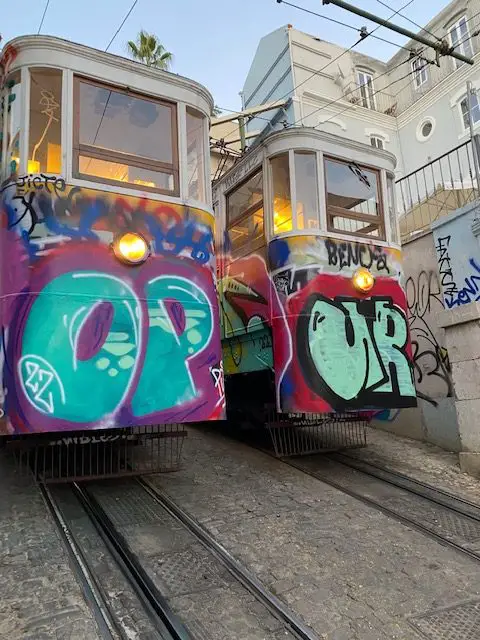
The Ascensor do Lavra was Lisbon‘s first funicular. Ascensor do Lavra – A quick guide
It started taking passengers up Calçada do Lavra from Avenida in 1884.
At the top visitors can walk a block to check out the Jardim do Torel park and viewpoint. Miradouro do Jardim do Torel – All you need to know
Each ascensor or funicular costs 3.80€ for a round trip ride (You have an hour to do the return trip). You can buy a ticket from the driver, or you can use the Lisboa Card Lisboa Card | Everything you need to know or the Viva Viagem card What is the Viva Viagem Card? Everything you need to know
Elevador da Santa Justa
This 150-foot tall neo-gothic tower was opened in 1902.
It was built by Raoul Mesnier du Ponsard, an apprentice of Gustave Eiffel.
The tower is actually an elevator that links the Baixa neighborhood downtown to the Chiado neighborhood on the hilltop.
At the top, you’ll find some of the best views of the city.
There is an observation deck which you must pay to enter.
The observation deck is €1.50, and the ticket to ride the elevator up and down is €5.30.
You can use the Lisboa card on the elevator, or a 24-hour public transportation ticket, or the zapping option on the Viva Viagem card.
If using a Viva Viagem card, you will have to pay cash for the observation deck.
There is a walkway that goes to the Largo Do Carmo, the Convento, and the Chiado neighborhood.
In order to use the elevator go to Rua do Ouro, which is near Rossio Square.
Expect long lines at the elevator. For more information, read my article Elevador de Santa Justa | Everything you need to know
Another great viewpoint nearby is the Arch on Rua Augusta. You can enter to go to the top at Rua Augusta 2. Tickets are €3.00. The lines for the arch are much shorter. To learn more, read my What is the story behind Lisbon’s Rua Augusta Arch?
Free elevators to the high ground
To the convent
In the event that you are not looking for the elevator experience or the observation deck, and you just want to get to the hilltop, one block west of Santa Justa, there is a free elevator in one of the department stores.
You can also use the escalators in the Baixa-Chiado metro station. Ride down, go through the turnstile for the metro, then take several escalators to the top.
To the castle
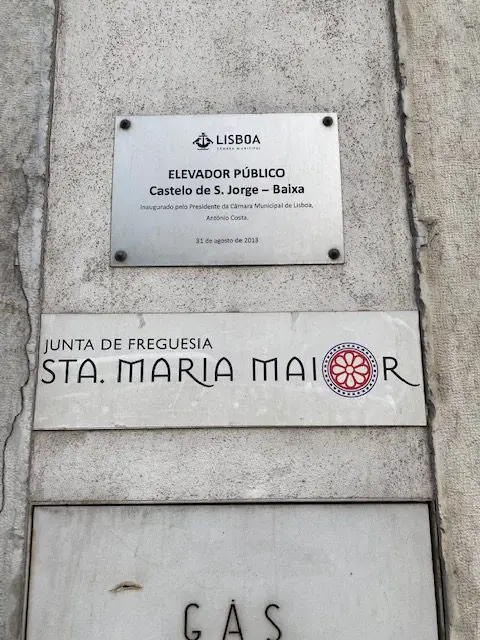
If you do not want to walk all the way up to the castle, you can combine two elevators to get closer to the hilltop.
In Baixa, you will find an elevator (Elevador do Castelo) at Rua dos Fanqueiros 170/178 that goes up to Rua da Madalena.
100 yards from there, you will find a second elevator (Elevador Baixa).
Cross the street diagonally towards Largo Chão do Loureiro, to the Chão do Loureiro building – an old market hall where Pingo Doce (a supermarket) is located. In the supermarket, the elevator goes up towards Restaurante Zambeze. You will have a great view when you get off the elevator.
From there, you have a ten-minute uphill walk to the castle. For more information on the free, public elevators, read my Lisbon’s secret elevators – free shortcuts to the hilltops
Or, take the 737 bus almost to the castle door.
Buses
Buses in Lisbon run from 6:30 AM until midnight.
Lisbon buses are yellow, and any yellow bus can be ridden for free with the Lisboa card or the Viva Viagem card, except the aerobus 91 that goes to and from the airport.
Nor are these cards valid on the intercity Rede Expressos buses, or the buses that operate on the other side of the river in Costa da Caparica.
If you are planning a day trip outside of Lisbon, you can find an intercity bus at the Sete Rios bus terminal outside of the Jardim Zoológico metro station.
If you do not want to walk up the hill to the castle and don’t want to wait in line for tram 28, take bus 737 which leaves from Praça da Figueira. The bus stops almost at the castle door.
If you are going to the tile museum, take bus 759 from Restauradores Square, and get off at Igreja Madre de Deus (Mueseu Azulejo).
If you are going to the LX factory or Belém, you can take bus 714 from Praça da Figueira. The LX Factory stop is Calvário.
The bus continues to Belém and stops in front of the Jerónimos Monastery.
It is a 30-minute ride.
Generally this bus is very crowded.
Bus fare is two euros if you were paying cash.
The ride is free with the Lisboa Card. If you are using zapping on the Viva Viagem, card each ride is 1.35 euros.
Conclusion
Lisbon’s trolleys, trams, streetcars, and elevators are all operated by the Carris Company.
The metro or subway is operated by Metro Lisboa. For more information on the Lisbon subway, I can offer you a few more tips in some of these other articles I wrote: Hotels located near metro stations in Lisbon , How to use public transportation to get to Lisbon’s beaches , and Lisbon Metro: A helpful guide to the Lisbon subway.
Both companies will honor the 24-hour Viva Viagem card, or a declining balance with zapping on the Viva Viagem card. These can be purchased at any metro station.
Carris and Metro Lisboa will also both honor the Lisboa Card, which you can buy for a fixed price for 24, 48, or 72 hours. It can be purchased at the airport or online. Lisboa Cards can be purchased at the airport or online.
Thank you for reading. I may earn a small commission if you purchase something from one of the Get Your Guide links on this page. Thank you for supporting this website.